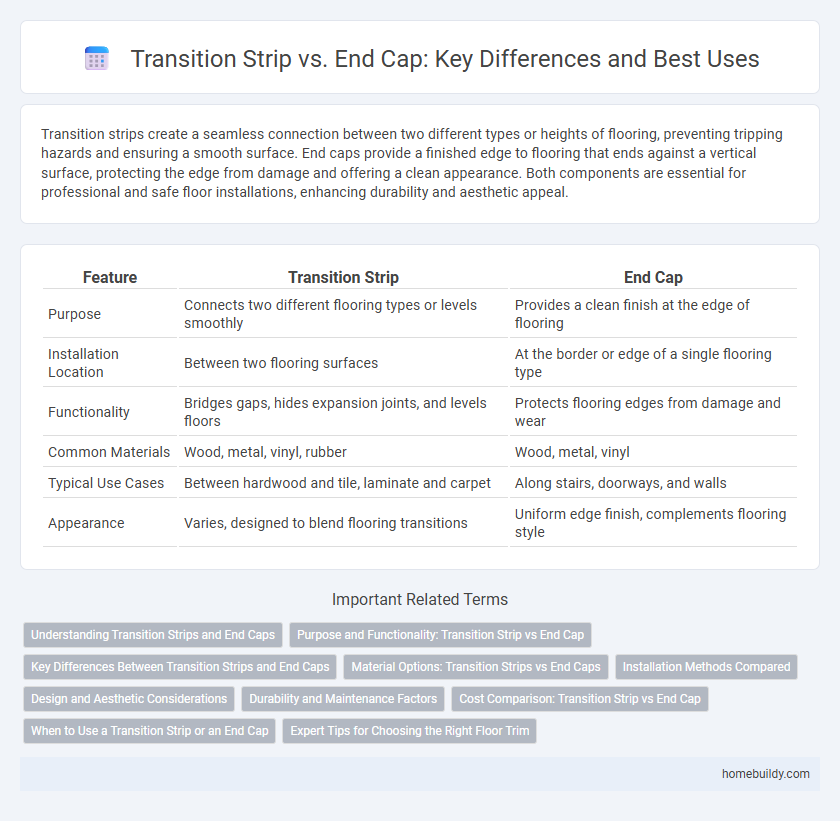Transition strips create a seamless connection between two different types or heights of flooring, preventing tripping hazards and ensuring a smooth surface. End caps provide a finished edge to flooring that ends against a vertical surface, protecting the edge from damage and offering a clean appearance. Both components are essential for professional and safe floor installations, enhancing durability and aesthetic appeal.
Table of Comparison
| Feature | Transition Strip | End Cap |
|---|---|---|
| Purpose | Connects two different flooring types or levels smoothly | Provides a clean finish at the edge of flooring |
| Installation Location | Between two flooring surfaces | At the border or edge of a single flooring type |
| Functionality | Bridges gaps, hides expansion joints, and levels floors | Protects flooring edges from damage and wear |
| Common Materials | Wood, metal, vinyl, rubber | Wood, metal, vinyl |
| Typical Use Cases | Between hardwood and tile, laminate and carpet | Along stairs, doorways, and walls |
| Appearance | Varies, designed to blend flooring transitions | Uniform edge finish, complements flooring style |
Understanding Transition Strips and End Caps
Transition strips bridge the gap between different flooring types, providing a smooth and safe surface to prevent tripping hazards. End caps, by contrast, are designed to finish the exposed edges of flooring, enhancing durability and aesthetic appeal. Understanding the distinct functions of transition strips and end caps is essential for proper flooring installation and long-term maintenance.
Purpose and Functionality: Transition Strip vs End Cap
Transition strips connect two different types or heights of flooring, ensuring a smooth and safe transition between surfaces while preventing tripping hazards. End caps are used to finish the exposed edges of flooring, providing a clean, polished look and protecting against damage and moisture infiltration. Both serve distinct purposes: transition strips bridge flooring changes, whereas end caps seal and protect flooring edges.
Key Differences Between Transition Strips and End Caps
Transition strips bridge the gap between two different flooring types, ensuring a smooth and safe transition, while end caps provide a finished edge where the flooring meets a vertical surface or an unconnected edge. Transition strips accommodate height and material differences between adjoining floors, preventing tripping hazards and protecting edges from damage. End caps, by contrast, serve primarily as a protective and aesthetic termination, sealing off exposed flooring edges for a polished, professional look.
Material Options: Transition Strips vs End Caps
Transition strips are commonly made from materials such as aluminum, wood, vinyl, or rubber to accommodate different flooring types and provide a smooth surface transition between rooms. End caps are typically crafted from similar materials but are specifically designed to finish the exposed edges of flooring, offering enhanced durability and aesthetic appeal. Both options allow customization through various finishes and colors, enabling seamless integration with surrounding floor surfaces.
Installation Methods Compared
Transition strips are installed by anchoring them to the subfloor with screws or using adhesive, allowing seamless connection between different flooring types. End caps are typically secured at the flooring edge using nails or adhesive, providing a clean finish against walls or thresholds. The installation of transition strips requires precise measurement and cutting to fit between two surfaces, while end caps focus more on edge protection and aesthetic closure.
Design and Aesthetic Considerations
Transition strips create a seamless, visually appealing bridge between different flooring types or levels, enhancing design continuity and spatial flow. End caps provide a clean, finished edge to flooring installations, preventing fraying and offering a polished boundary for doorways or staircases. Both options contribute to aesthetic cohesion, but transition strips prioritize smooth visual transitions while end caps emphasize defined, neat terminations.
Durability and Maintenance Factors
Transition strips provide superior durability compared to end caps due to their robust construction designed to absorb foot traffic and prevent floor damage at material junctions. Maintenance requirements for transition strips are minimal, involving occasional cleaning and inspections, whereas end caps may necessitate more frequent replacement or repairs due to their smaller coverage and vulnerability to chipping. Choosing transition strips enhances long-term floor integrity and reduces maintenance efforts in high-traffic areas.
Cost Comparison: Transition Strip vs End Cap
Transition strips generally cost more than end caps due to their larger size and complexity in design, which accommodates multiple flooring types and height differences. End caps are more affordable as they serve a simpler purpose--finishing the edge of flooring without bridging gaps. Choosing between a transition strip and an end cap often depends on budget constraints and the specific flooring application requirements.
When to Use a Transition Strip or an End Cap
Transition strips are best used to bridge the gap between two different types or heights of flooring, providing a smooth and safe surface that accommodates expansion and contraction. End caps are ideal for finishing the exposed edge of flooring that meets a vertical surface such as a wall or a doorway threshold. Choosing between a transition strip and an end cap depends on whether you need to connect two flooring surfaces or simply seal off the edge of a single floor area.
Expert Tips for Choosing the Right Floor Trim
Transition strips create seamless connections between different flooring types, while end caps provide a finished edge at the end of flooring runs. Experts recommend selecting a transition strip based on floor height differences and material compatibility to ensure durability and aesthetic appeal. Proper measurement and matching with the floor design are key factors for choosing the right floor trim.
Transition strip vs End cap Infographic

 homebuildy.com
homebuildy.com